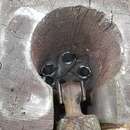en
names in breadcrumbs


A small (4 ½ inches) songbird, the Carolina Chickadee is most easily identified by its gray back and tail, pale breast, black chin, and black cap. However, positive identification of this species is complicated where its range overlaps with that of the closely related Black-capped Chickadee (Poecile atricapillus). Carolina Chickadees are generally smaller and darker-winged than their northern relatives, but it is often impossible to separate the two species in the field by physical appearance alone. Hybrids with mixed physical and vocal characteristics do occur, further complicating identification. Male and female Carolina Chickadees are similar to one another in all seasons. The Carolina Chickadee breeds across much of the southeastern United States from the Mid-Atlantic south to central Florida and west to Texas. This species’ range overlaps with that of the Black-capped Chickadee in a narrow band stretching from the Mid-Atlantic region west to Kansas, particularly where that species’ range dips southward at higher elevations in the lower Appalachian Mountains. Carolina Chickadees are generally non-migratory. Carolina Chickadees inhabit a number of forest types, including deciduous and mixed deciduous-evergreen woodland habitats. This species also utilizes human-altered habitats, and may be found in urban and suburban areas where food and sufficient tree cover are available. Carolina Chickadees eat a variety of plant and animal foods, with insects predominating in summer and seeds becoming more important in winter. In appropriate habitat, Carolina Chickadees may be observed foraging for food in the tree canopy, often hanging from the ends of branches while eating seeds or picking insects off of leaves and bark. This species is also a common backyard feeder bird, visiting feeding trays as part of mixed flocks of small songbirds. This species’ song, a whistled “fee-bee, fee-bay” and its call, a clear “chick-a-dee-dee-dee,” are both higher-pitched than those of the Black-capped Chickadee. Carolina Chickadees are primarily active during the day.